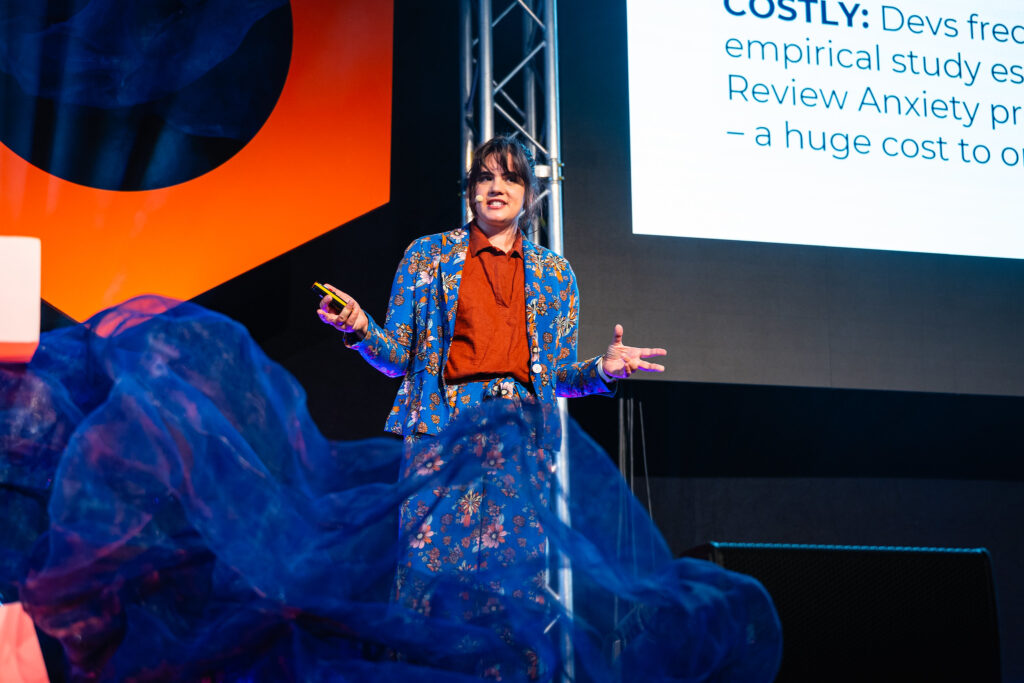Author: Csongor János Pup
Who Is Dr. Cat Hicks?
Dr. Cat Hicks is the founder and principal scientist at Catharsis Consulting, where she leads research on the psychology of technical teams. With a background in cognitive science and a focus on evidence-based organizational change, she brings deep expertise in developer experience, learning culture, and team resilience.

Debunking the Lone Genius Myth
In a deeply moving talk at Craft Conference, Dr. Hicks dismantled the myth of the lone technical hero and replaced it with something far more compelling: a vision of healthy software teams built on evidence, resilience, and belonging.
Drawing on research with over 5,000 developers and engineering managers across 12+ industries, Hicks made a provocative case: the real technical risk isn’t a lack of brilliance. It’s the psychological gap created when organizations obsess over short-term performance.
The Hidden Costs of Invisibility
“Only 24% of developers,” she revealed, “believe their technical work is actually seen.” That number is even lower for those in less ‘traditional’ roles like DevOps or QA.
This invisibility, she explained, breeds distress and avoidance. Her research uncovered a 40% avoidance rate in code reviews among individuals with high Code Review Anxiety – a silent cost that undermines productivity, learning, and retention.
The LABS Model: Building Resilient Productivity
To counter this, Hicks introduced the LABS model – Learning culture, Agency, Belonging, and Self-efficacy – a framework that predicts resilient productivity. She stressed that these psychological metrics aren’t “soft” extras but essential foundations: “When something breaks, brittle productivity collapses. Resilient productivity adapts.”
AI Skill Threat and the Brilliance Myth
Hicks also coined the term AI Skill Threat – a measurable fear among developers that the accelerating pace of technological change will outstrip their ability to remain valuable. This fear is amplified by toxic contest cultures and “brilliance myths” that glorify innate genius over collective development. “If programmers believe their value lies in being born clever,” Hicks warned, “they’re less likely to ask for help, to give back, or to innovate inclusively.” These beliefs aren’t just demoralizing – they’re unsafe.
Designing Adaptive Team Environments
So what’s her antidote? Design environments that foster adaptive mindsets. Use rigorous psychological science to create spaces where learning is expected, risk-taking is supported, and team membership feels real. Interventions, she argued, must be evidence-based, peer-reviewed, and transparent. “We can run scientific experiments in real-life development,” she said. “And we have to.”

From Brains-in-Jars to Prosocial Teams
Hicks closed with a powerful call to action for leaders and practitioners alike: protect the problem-solving community. “Software development is not antisocial,” she reminded us. “It’s deeply prosocial.”
One of the stickiest myths she skewered was the brains-in-jars model: the idea that developers are just floating intellects, churning out code in isolation, devoid of emotion, context, or connection. It’s a sci-fi fantasy, not a workplace reality. “We’re not brains in jars,” she implied. “We’re humans, shaped by our teams, environments, and beliefs.” Clinging to this myth doesn’t just make work less joyful; it actively undermines collaboration, learning, and long-term success.
In an age of hyper-speed technological change, Dr. Cat Hicks didn’t just offer hope – she offered a map. A map that shifts the focus from who’s the best developer to a far more important question: do our systems allow everyone to thrive?